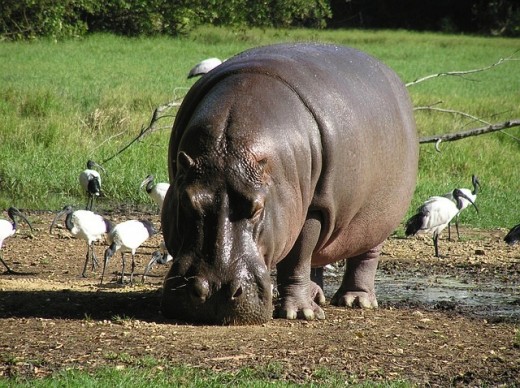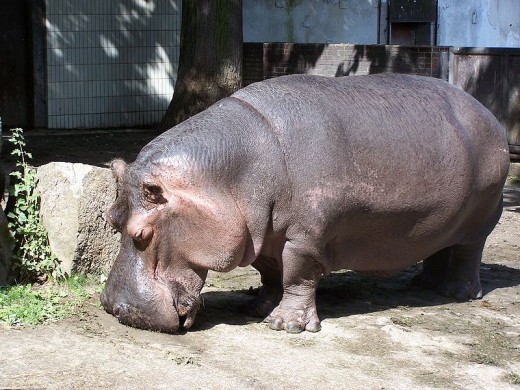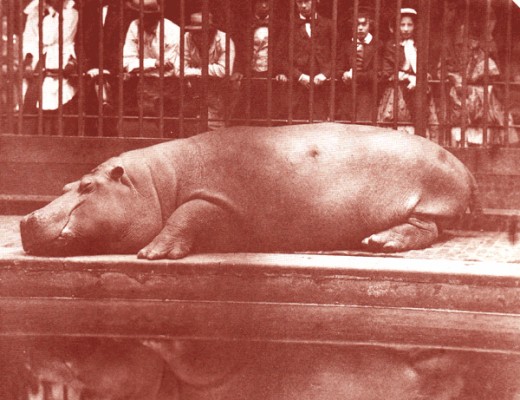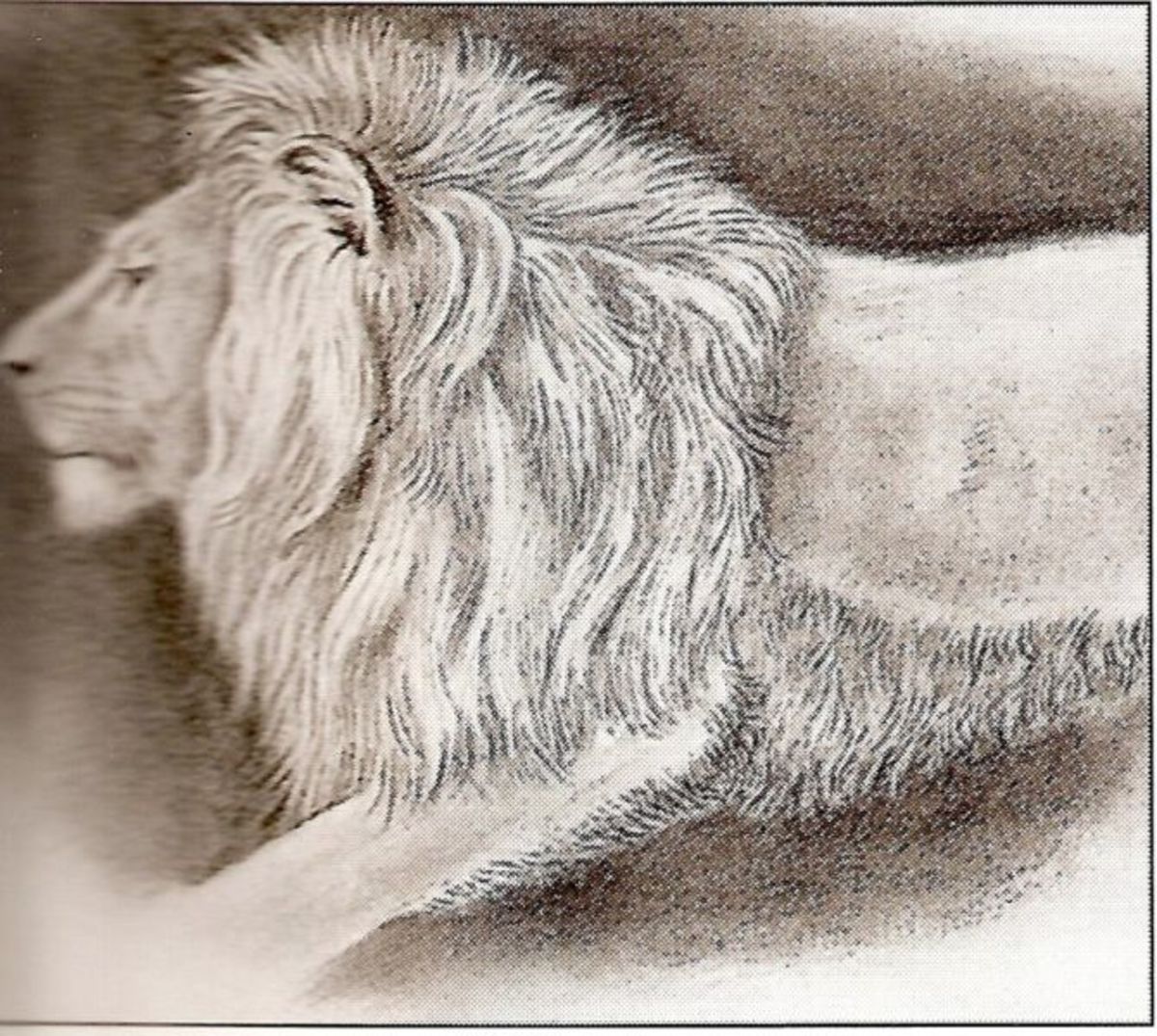Common Hippo
Scientific Name: Hippopotamus amphibius

Description
The early Egyptians had plenty to question about the Common Hippo. They knew it to be a powerful animal that weighed about three tons. They also knew it to be a fierce defender of its offspring. This was a characteristic that they took as being a symbol from the gods about how a mother and a child have a bond that can’t be broken.
Interesting Links
- Hippopotamus Facts and Information
Hippopotamus Facts and Information. Feeding, habitat, distribution, reproduction, anatomy and more. Facts about the Common Hippopotamus, the Pygmy Hippopotamus and more and the conservation efforts made to preserve hippopotamus - Hippopotamus Calf - Facts and Information - The Portal of Life
Facts and Information about Hippopotamus Calf. Hippopotamus Calf Description, Behavior, Feeding and Reproduction.
Anatomy
The toes of the Common Hippo are very interesting. You will notice that they have four toes on each foot. Yet they also have webbing between them and that is what gets them around with ease in the water. They are quite versatile and it all comes down to the overall anatomy of them. You may think it is silly that they have nostrils on top of their head but it is one more way that the body format works so well for their needs.
The huge middle section of the body for a Common Hippo is where our human eyes often center. If you get yourself to look at other things though you will notice a small tail and some small ears. You will also notice skin that is a brownish gray and very wrinkled. The body of a Hippo will continue to expand until they reach an age of about 25 years.


Interesting Links
- Elephant Facts
Elephant Facts and Information. Feeding, habitat, distribution, reproduction, anatomy and more. Facts about the African Elephant and the Asian Elephant and the conservation efforts made to preserve Elephants. - Facts about Crocodiles, Alligators, Caymans
Crocodile. Alligator and Caiman Facts and Information. Feeding, habitat, distribution, reproduction, anatomy and more. Facts about the Nile Crocodile, the Saltwater Crocodile, the Black Caiman, the American Alligator among others and the conservation
Evolution
Ask several researchers about the evolution of the Common Hippo, and you are sure to get lots of different answers. That is because we have many theories floating around and parts of several of them could be right. We like to think that the Hippo is directly liked to pigs but that is an assumption that has been discredited through DNA testing.
We do have fossilized remains of Hippos that are millions of years old. They indicate that these Hippos were in various regions and that they were much smaller. That is a fact that encourages many experts to believe the increase in size is part of what really helped the Common Hippo to survive when other species failed to do so.
Common Hippo Video
Behavior
Don’t underestimate just how aggressive a Common Hippo can be. They are responsible for more deaths than other animals out there. Villagers that live in Africa constantly have a fear of these animals. They are quite vocal and they have the ability to have a sound be heard both in the water and in the air at the same time.
Dominance is very important when it comes to the males. Only the top dog will be able to mate. The bachelor males have several choices – to stay but not mate, to go out on their own to create a herd they can mate with, or to challenge the leader in the hopes of overthrowing him.
Even though the Common Hippo is very aggressive, the females are very bonded with their young. They go to extremes with members of the herd, humans, and other animals to protect them. They are patient and loving to their young and really seem to enjoy being around them.
Interesting Links
- Monkey Facts and Information
Monkey Information, Anatomy, Feeding, Communication, Reproduction, Predators and Monkey Conservation. Facts about Baboons, Capuchin Monkeys, Common Marmosets, Squirrel Monkeys and more - Lion Facts
The lion (Panthera leo) is one of the four big cats in the genus Panthera and a member of the family Felidae.
Habitat and Distribution
The biggest place for the Common Hippo to be found out there is in Africa – the East part of it to be exact. They are found in swamps, rivers, and lakes. They need water that is deep enough to cover the body. Yet they don’t want it to be much deeper than that. They like water that moves slowly or that is still. They also like that water to be clean.
Most of the time the Common Hippo isn’t in captivity. They are extremely large and they take up too much room. They are more expensive to feed than the Pygmy Hippo. At the same time, that particular species is at a high risk of soon becoming extinct. It is more practical for them to be protected in the zoos at this time.
Diet and Feeding Habits
In the five hours or so that the Common Hippo is on land at night, they will consume up to 150 pounds of food. This is all plant life as they are herbivores. They also tend to create havoc for the villagers as they will eat lots of the crops they are trying to make for their own survival.
Humans continue to be a huge problem for the survival of the Common Hippo. As more and more of their land is taken away, they have less to explore in search of food. This can result in lower numbers of them. It also increases the risk of the young dying. A mother may have to leave it behind to go on and get food she needs.


Reproduction
Mating is a year round process for the Common Hippo. When a female is in estrus the lead male will be able to mate with her. There is a very small two day process where this occurs. We don’t get to see much of the mating rituals when they get together. They mate in the water so we don’t get to see all of the details.
A young Common Hippo can be born weighing as much as 75 pounds. This event will occur in the water. It is going to happen about 8 months after the mating has been completed. In spite of the fact that the Common Hippo is one of the most violent creatures out there, it is also one of the gentlest when it comes to caring for her offspring.
Common Hippo Video
- Facts about Pollution | Effects of Pollution
Pollution Facts and Information. Effects of Pollution in the Environment
Predators
There are some predators that will take a risk and try to attack a baby Common Hippo. This includes the alligator, crocodile, lions, and hyenas. They will wait until this young Hippo has moved away from the mother and then swoop in. Many of these predators have died trying though as they underestimate how fast the mother is going to come to the rescue of her little one.
If only humans and the Common Hippo could live in harmony they would be doing quite well out there in the wild. Yet humans have a desire to take over the land where these animals have lived for so long. They expect the aggressive Common Hippo to change but that isn’t practical. Instead, they use force to destroy it every chance that they get. This includes hunting as a sport or to use the Common Hippo as a source of food.
Poaching to be able to destroy them for the ivory of the teeth is a huge concern. The selling of ivory has been banned for a very long time. However, such laws are hard to enforce. The fact that ivory is hard to come by means that there is a huge amount of money people will pay for it. For those that are desperate for survival, selling Common Hippo teeth is worth the risk of getting caught.
Through conversation efforts though, perhaps the wrong doings of humans can be changed. People need to see the value in the ecosystem of the Common Hippos. They also need to realize that these animals need to be left alone to thrive in their own environment. Until that time comes though there are concerns that the numbers of them will only continue to get smaller.







